Brooke |
||||||||||||||||||||||
|
|
||||||||||||||||||||||
DROPS crochet jacket with mussel pattern in “Alpaca” and “Cotton Viscose”. Size S - XXL
DROPS 99-1 |
||||||||||||||||||||||
|
GAUGE: 14 dc x 7 rows with 1 strand of each quality = 10 x 10 cm [4" x 4"]. 1 repeat of mussel pattern = width approx 11 cm [4⅜"]. CROCHET INFO: At the beg of each round replace the first dc with ch 3. Replace first tr with ch 4. Finish each round with 1 sl st in 3rd/4th ch from beg of round. PATTERN: See diagrams M.1 and M.2. The diagram is seen from the RS. MEASURING TIPS: Because of the weight of the yarn all measurements should be made whilst the garment is hanging. _______________________________________________________________ BODY: The jacket is crochet from the top down and back and forth with opening mid front. Loosely ch 92-97-97-105-113 (includes 3 ch to turn with) on crochet hook size 4.5 mm [US 7] with 1 strand Alpaca and 1 strand Cotton Viscose (double strands held together). Crochet next row as follows: 1 dc in 4th ch, *skip 1 ch, 1 dc in each of the next 3 ch*, repeat from *-* (in size M, L, XL and XXL finish with 1 dc in the last ch) = 68-72-72-78-84 dc – see Crochet info. On next row work 1 dc in each dc and at the same time inc 14-13-10-19-19 dc (inc by working 2 dc in 1 dc) evenly on row (do not inc on 5 dc each side = front bands) = 82-85-82-97-103 dc. Now crochet 10 rows following chart M.1 (5 dc each side = front bands and are not to be part of diagram, on these sts work 1 dc in each dc). After chart M.1 there are 190-210-226-242-258 dc on row. Continue with 1 dc in each dc until piece measures 20-21-23-23-24 cm [8"-8 ¼"-9"-9"-9½"]. Crochet next row as follows: 5 dc on front band, 26-28-31-35-39 dc (= front piece), ch 7-8-8-8-9 (under arm), skip 38-45-45-45-45 dc from previous row (= armhole, sts to be used later for sleeve), 52-54-64-72-80 dc (= back piece), ch 7-8-8-8-9 (under arm), skip 38-45-45-45-45 dc from previous row (= armhole, sts to be used later for sleeve), 26-28-31-35-39 dc ( = front piece), 5 dc on front band. Next row: crochet 1 dc in each dc and each ch = 128-136-152-168-186 dc. On next row work 1 dc in each dc and at the same time inc 9-19-21-23-23 dc evenly = 137-155-173-191-209 dc. Then crochet 1 row with 1 sc in each dc (also on sts on front bands) and then continue following chart M.2 (beg at arrow in diagram). Work 1 vertical repeat of chart M.2, and begin the second repeat by Arrow B in diagram. After second repeat om M.2 the piece measures approx 44-45-46-47-48 cm [17 ¼"-17 ¾"-18"-18½"-19"]. Now crochet 3-3-4-4-4 rows of tr as follows (also on front band sts): Row 1: Remember crochet info! Work 1 tr in each ch-space, and ch 1 between each tr, finish row with 1 tr in the last st = 64-73-82-91-100 tr + 5 tr on each front band. Row 2: 1 tr in each tr from previous row, but now ch 2 between each tr (instead of 1). Row 3: 1 tr in each tr from previous row, but now ch 3 between each tr. Note – finish size S and M here and skip row 4 below = 64-73 tr + + 5 tr on each front band. Row 4 (Size L - XL – XXL): 1 tr in each tr from previous row with ch 3 between each tr. Note - finish size L, XL and XXL here = 82-91-100 tr + 5 tr on each front band. All sizes: Now crochet diagram M.2 again (beg at start arrow in diagram). Note! Crochet row 1 in M.2 as follows to make pattern fit (work 5 front band sts each side as before): 5 band sts, ch 1, 1 dc in the first tr, ch 1, *1 dc in the next tr, ch 1, 1 dc in ch-space, ch 1*, repeat from *-* = 126-144-162-180-198 ch-spaces (i.e. 14-16-18-20-22 repeats of mussel pattern at bottom of jacket). End working the pattern after row 7. Fasten off. Sleeve: Crochet from armhole towards bottom edge. Beg mid under arm as follows: crochet 1 sc in the 4th -5th -5th -5th -5th ch of the 7-8-8-8-9 ch worked under the arms on front and back piece. Ch 3 (= 1 dc) and continue with 1 dc in each ch. Note! Before continuing working around armhole crochet 1 dc in the transition to avoid a hole. Continue with 1 dc in each dc along armhole and crochet 1 dc in the transition before crocheting 1 dc in the remaining ch under the arm = 47-55-55-55-56 dc. Crochet in the round like this until sleeve piece measures 9-10-9-9-10 cm [3½"-4"-3½"-3½"-4"]. Now crochet next round as follows: Size S: Crochet 5 dc mid under arm, continue in M.2 (from start arrow in diagram) = 2 repeats of mussel pattern and finish with 6 dc. Crochet 1 vertical repeat of M.2. Now crochet 1 row of tr as follows: crochet in the first 5 dc like this: ch 4 (= 1 tr), *1 ch, skip 1 dc, 1 tr in the next dc*, repeat from *-*. Continue on mussel pattern like this: *ch 1, 1 tr in next dc*, repeat from *-*. Crochet in the last 6 dc like this: *ch 1, skip 1 dc, 1 tr in the next dc*, repeat from *-* = 23 ch-spaces. Size M + L + XL: Ch 3 and continue in M.2 (from start arrow in diagram) = 3 repeats of mussel pattern + 1 dc mid under arm. Crochet 1 vertical repeat of M.2. Now crochet 1 row of tr as follows: ch 4 (= 1 tr), ch 1, *1 tr in next dc, ch 1*, repeat from *-* and finish with 1 sl st in 4th ch from beg of round = 27 ch-spaces. Size XXL: Ch 3 and continue in M.2 (from start arrow in diagram) and finish with 1 dc mid under arm = 3 repeats of mussel pattern + 2 dc mid under arm. Crochet 1 vertical repeat of M.2. Now crochet 1 row of tr as follows: ch 4 (= 1 tr), ch 1, skip 1 dc, *1 tr in next dc, ch 1*, repeat from *-* and finish with 1 sl st in 4th ch from beg of round = 28 ch-spaces. All sizes: Now crochet 7-6-6-6-5 rounds as follows: ch 4 (= 1 tr), ch 1, 1 tr in the first tr, *ch 1, 1 tr in next tr*, repeat from *-* and finish with 1 sl st in the 4th ch from beg of round. After the last round crochet M.2 again (from start arrow in diagram), but crochet the first round as follows to make the pattern fit: Size S: ch 3 (= 1 dc), *ch 1, 1 dc in next ch-space, ch 1, 1 dc in the same ch-space, ch 1, 1 dc in the next ch-space*, repeat from *-* and finish with 1 sl st in the 3rd ch from beg of round. There are now 36 ch-spaces (= 4 repeats of mussel pattern at the bottom sleeve edge). Finish M.2 after row 7. Size M + L + XL: ch 3 (= 1 dc), *ch 1, 1 dc in next ch-space, ch 1, 1 dc in the next ch-space, ch 1, 1 dc in the next ch-space, ch 1, 1 dc in the same ch-space*, repeat from *-* and finish with 1 sl st in the 3rd ch from beg of round. There are now 36 ch-loops (= 4 repeats of mussel pattern at the bottom sleeve edge). Finish M.2 after row 7. Size XXL: ch 3 (= 1 dc), *ch 1, 1 dc in next ch-space, ch 1, 1 dc in the next ch-space, ch 1, 1 dc in the next ch-space, ch 1, 1 dc in the next ch-space, ch 1, 1 dc in the same ch-space*, repeat from *-* and finish with 1 sl st in the 3rd ch from beg of round. There are now 36 ch-spaces (= 4 repeats of mussel pattern at the bottom sleeve edge). Finish M.2 after row 7. Button covers: Crochet covers for 5-6-6-6-6 buttons on crochet hook size 3 mm [US C] with Cotton Viscose as follows: 1st round: ch 2, 16 dc in the first ch and finish with 1 sl st in first dc. 2nd round: 1 sc in each dc and finish with 1 sl st in first sc from beg of round. 3rd round: ch 3, 1 dc in every other sc and finish with 1 sl st in 3rd ch from beg of round = 8 dc Put button inside cover, sew round the opening and pull tight. Assembly: Sew on buttons to left front piece as follows: Size S: 1, 12, 23, 34 and 44 cm [3/8"-4 ¾"-9"-13⅜"-17 ¼"]. Size M: 1, 10, 19, 28, 37 and 45 cm [3/8"-4"-7½"-11"-14½"-17 ¾"]. Size L: 1, 10, 19, 28, 37 and 46 cm [3/8"-4"-7½"-11"-14½"-18"]. Size XL: 1, 10, 20, 29, 38 and 47 cm [3/8"-4"-8"-11⅜"-15"-18½"]. Size XXL: 1, 10, 20, 29, 39 and 48 cm [3/8"-4"-8"-11⅜"-15 ¼"-19"]. Crochet border: Beg at the bottom of right front band. Crochet 2 sc in each dc up along front band, crochet 1 sc in each dc round neckline and crochet down left front band as described for right front band. At the same time crochet buttonhole loops on right front band as follows: 5 ch, skip approx 2 cm [3/4"], 1 sc in next st (make sure to position the buttonhole loops in line with buttons on left front band). |
||||||||||||||||||||||
Diagram explanations |
||||||||||||||||||||||
|
||||||||||||||||||||||

|
||||||||||||||||||||||
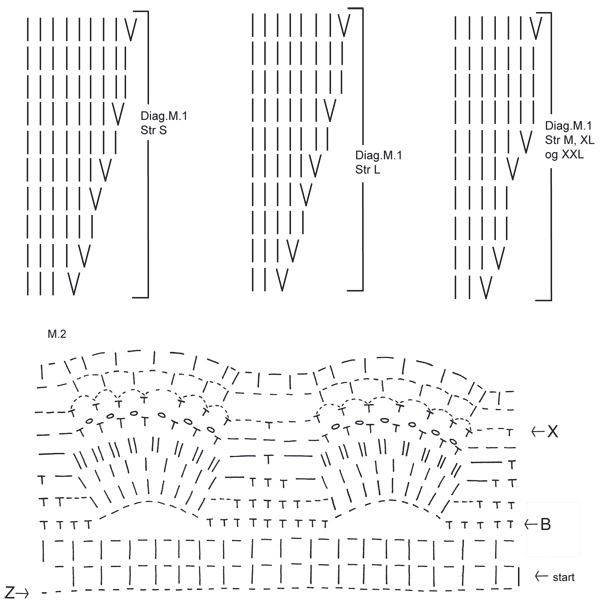
|
||||||||||||||||||||||
|
Have you made this or any other of our designs? Tag your pictures in social media with #dropsdesign so we can see them! Do you need help with this pattern?You'll find tutorial videos, a Comments/Questions area and more by visiting the pattern on garnstudio.com. © 1982-2024 DROPS Design A/S. We reserve all rights. This document, including all its sub-sections, has copyrights. Read more about what you can do with our patterns at the bottom of each pattern on our site. |
||||||||||||||||||||||






















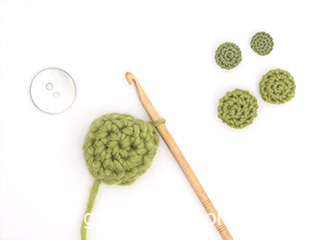

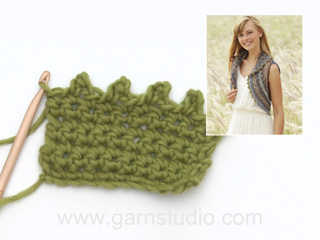

















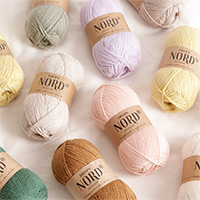
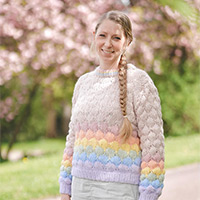
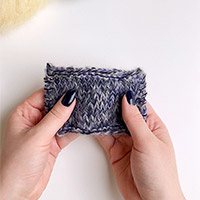
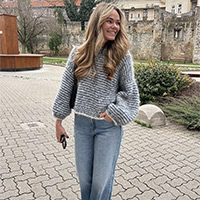

Comments / Questions (216)
Please advise which 5 stitches are required at either side (the bands) while M2 is being worked. Should they be double crochet or treble stitches? I’ve put double crochet stitches but they are pulling the pattern. Please advise?
29.03.2021 - 20:04En M2 en filas 4 y 5 hay una linea bastante mas larga que una cadena que quiere decir.
24.04.2020 - 01:34DROPS Design answered:
Hola Karla. La línea recta significa un punto de cadeneta. Debido a la combinación con otros puntos en algunas filas estas líneas aparecen más alargadas que en otras.
30.04.2020 - 23:58Hej! Kommer ni att ersätta cotton/viscose med ett liknande garn? Sådan kvalitet är ljuvlig att bära!
06.01.2020 - 17:27DROPS Design answered:
Hej Kajsa, Ja Cotton Viscos var superfin och den är saknad. Du kan använda DROPS Safran som också är lite blank. Lycka till :)
15.01.2020 - 16:05Please translate to English. Would love to crochet this cardigan Many thanks
19.12.2019 - 22:37DROPS Design answered:
Dear Helena, you can find the English translation here: https://www.garnstudio.com/pattern.php?id=3325&cid=19 Happy crocheting!
26.12.2019 - 22:51Hi, I don’t understand how you get from 82 stitches in the beginning to 190 following M1. My understanding of the chart is that the increase only at the beginning and end of the row Thank you
03.11.2019 - 14:40DROPS Design answered:
Dear Ivana, you will increase in each repeat of the diagram as shown in diagram, ie in every repeat. In size S you work M.1 over 4 sts and repeat M.1 a total of 18 times in width, when M.1 is finished, there are 10 sts in each M.1 = 180 sts + 5 front band sts on each side = 190 sts. Happy crocheting!
04.11.2019 - 17:07Parabéns, são lindos!😘👏🏻👏🏻👏🏻😊
09.08.2019 - 07:22Bonjour, je trouve dommage, que l'explication n'est pas vraiment top. Par exemple au modèle M2, c'est pas noter qu'il faut continuer à faire les 2 bords devant de 5 brides selon la photo. Autrement c'est assez bien. Merci
07.08.2019 - 09:43Bonjour, J'aime beaucoup vos modèles, mais je trouve dommage que les dessins ne sont pas toujours compréhensible. Par exemple au diagramme M2, que signifient les ligne horizontale? Il y en a de toutes les longueurs. Merci d'avance
01.08.2019 - 13:32Bonjour, je trouve dommage, que l'explication n'est pas vraiment top. Par exemple au modèle M2, c'est pas noter qu'il faut continuer à faire les 2 bords devant de 5 brides selon la photo. Autrement c'est assez bien. Merci
30.07.2019 - 09:47I'm making the size XL & I have started this 3 times & EVERY TIME I end the 1st row, I am 1 stitch short. I thought it was coz I counted short but after a further 2 attempts, decided to draw it out & count them that way. & I have to say, I now know didn't count short, the start ch numbers are wrong for the larger sizes to end with 78 dc's & 1 dc at the end to do that I would have to ch 106 to end with 78dc. Is the rest of this pattern wrong for XL sizes?
14.07.2019 - 14:59DROPS Design answered:
Dear Mrs Zawadzki, the first 3 chains are the turning chains and count as first stitch, so that you should have the correct number of stitches: 1 dc in 4th ch fro hook (= 2 sts - 4 chains), *skip 1 ch, 1 dc in next 3 ch* x 25 (= 3 dc x 25 = 75 dc worked over 4 ch x 25 = 100 ch), 1 dc in last chain ( = 1 dc worked over 1 chain) = 2+75+1 = 78 dc worked over 4+100+1= 105 chains. Happy crocheting!
15.07.2019 - 10:25